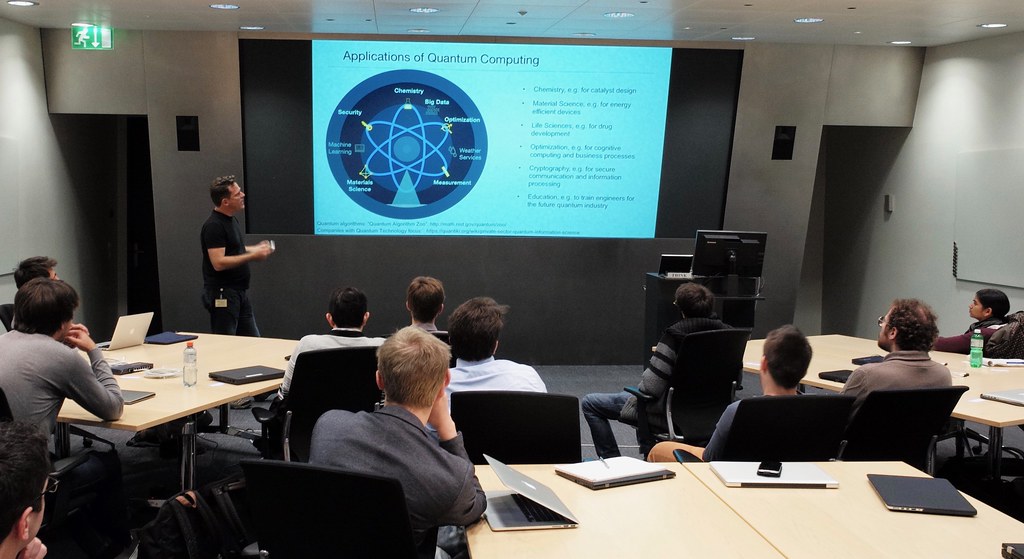Context:
The world celebrated the third annual World Quantum Day on 14 April 2024.
World Quantum Day
- It is an annual celebration promoting public awareness and understanding of quantum science and technology around the world.
- It is an initiative from quantum scientists from 65+ countries.
- It was first announced in 2021, with the inaugural celebration on April 14, 2022.
- It shifts world focus to all the quantum pillars and domains, including quantum computing, quantum communications, and quantum sensing and quantum metrology.
Quantum mechanics
- It is a subfield of physics that describes the behaviour of particles — atoms, electrons, photons and almost everything in the molecular and sub molecular realm.
- It explains how extremely small objects simultaneously have the characteristics of both particles (tiny pieces of matter) and waves (a disturbance or variation that transfers energy).
Why is it celebrated on April 14?
- April 14 is a reference to 4.14, the rounded first digits of Planck’s constant: 4.1356677×10−15 eV⋅s = 0.000 000 000 000 004 1356677 electron volt second, a product of energy and time that is the fundamental constant governing quantum physics.
What is the Planck Constant?
Quantum mechanics show us that energy is exchanged in specific amounts, known as quanta. The Planck constant defines how much energy is in those quanta.
India’s Initiative for Quantum Mechanics
- The National Quantum Mission (NQM), planned for 2023-2031 and conceptualized by the Prime Minister Science Technology Advisory Council (PM-STIAC), has received Union Cabinet approval.
- The NQM aims to seed, nurture, and scale up scientific and industrial R&D and create a vibrant & innovative ecosystem in Quantum Technology (QT).
- The Mission aims to establish four Thematic Hubs (T-Hubs) in domains such as
- Quantum Computing
- Quantum Communication
- Quantum Sensing & Metrology
- Quantum Materials & Devices.
- India is the seventh country to have a dedicated quantum mission after the US, Austria, Finland, France, Canada and China.
Use of Quantum Mechanics
- It helps to develop technologies such as LEDs, lasers, and ultra-precise atomic clocks used in the Global Positioning System.
- The semiconductor chips in our smartphones and computers operate in part using quantum mechanics.
- Magnetic Resonance Imaging (MRI) scanners in hospitals use quantum mechanics.
- Quantum Cryptography and encryption are indispensable components of protecting critical institutions such as Banks and Electrical grids.
Challenges
- The threat emerging from quantum computers that breach the encryption algorithms used by conventional computing systems needs to be addressed by Quantum Key Distribution (QKD) and Post-Quantum Cryptography (PQC) to make the world quantum-safe.
- Quantum Key Distribution (QKD) and Post-Quantum Cryptography (PQC) are two major approaches to quantum-safe data protection that are currently under active development.
- Ensuring ethical development and deployment of quantum technology.
- Qubit’s short lifespan: One major challenge to widespread quantum computing adoption is the qubit’s fragile state. Existing technologies can only keep the information in a quantum state for brief periods, limiting the duration of calculations.
- Inefficient error correction: Qubits are much more likely to suffer computational faults than classical computing built on transistors and traditional storage technology.
Way forward
- Thematic Hub Establishment: Accelerate the setup of Thematic Hubs (T-Hubs) for Quantum Computing and related materials to drive collaborative research.
- Research and Development Investment: Continuously invest in R&D to fuel quantum technology advancements and innovation.
- International Collaboration: Partner with leading nations in quantum technology to leverage expertise and accelerate progress.
- Focus on Quantum Security: Develop Quantum Key Distribution (QKD) and Post-Quantum Cryptography (PQC) solutions to safeguard data from quantum computing threats.

